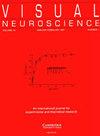对Kuraku et al., 2020的回应。
IF 2.3
4区 医学
Q4 NEUROSCIENCES
引用次数: 1
摘要
本文章由计算机程序翻译,如有差异,请以英文原文为准。
Response to Kuraku et al., 2020.
In our recent article, Fasick et al. (2019), we examined 18 amino acid positions in the whale shark Rh1 gene that have previously been identified to influence the spectral tuning of Rh1 pigments. Based on this analysis, we established a predicted absorbance value of 496 nm for whale shark Rh1. A recent paper by Hart et al. (2020) confirms the model that we presented by comparing spectral tuning residues between whale shark Rh1 and bamboo shark Rh1. Hart et al. examined 46 spectral tuning positions and concluded that the 2 Rh1 sequences possessed identical residues at all spectral tuning positions involved with the wavelength modulation of normal, wildtype Rh1 pigments. We came to the conclusion that Hara et al. may have expressed whale shark RRh rather than Rh1 based on the fact that RRh pigments typically maximally absorb light <480 nm; only the RRh and not the Rh1 opsin sequence was curated in the Hara et al. supplemental files; and that the current modeling data supported a whale shark Rh1 pigment that maximally absorbs light near 500nm. Given the fact that Hara et al. state that whale shark Rh1 and not RRh was expressed by Hara et al., we acknowledge that they expressed a pigment with an absorbance maximum of 478 nm.
求助全文
通过发布文献求助,成功后即可免费获取论文全文。
去求助
来源期刊

Visual Neuroscience
医学-神经科学
CiteScore
2.20
自引率
5.30%
发文量
8
审稿时长
>12 weeks
期刊介绍:
Visual Neuroscience is an international journal devoted to the publication of experimental and theoretical research on biological mechanisms of vision. A major goal of publication is to bring together in one journal a broad range of studies that reflect the diversity and originality of all aspects of neuroscience research relating to the visual system. Contributions may address molecular, cellular or systems-level processes in either vertebrate or invertebrate species. The journal publishes work based on a wide range of technical approaches, including molecular genetics, anatomy, physiology, psychophysics and imaging, and utilizing comparative, developmental, theoretical or computational approaches to understand the biology of vision and visuo-motor control. The journal also publishes research seeking to understand disorders of the visual system and strategies for restoring vision. Studies based exclusively on clinical, psychophysiological or behavioral data are welcomed, provided that they address questions concerning neural mechanisms of vision or provide insight into visual dysfunction.
 求助内容:
求助内容: 应助结果提醒方式:
应助结果提醒方式:


